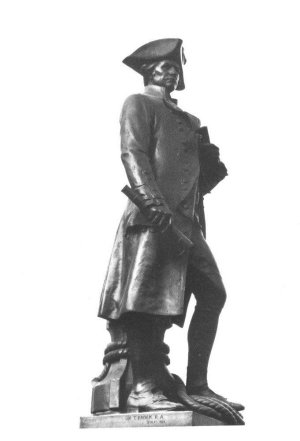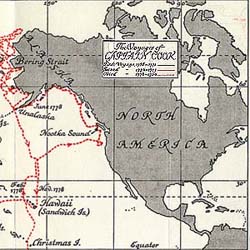INFORMATION
Tour Home
Contact Us
Copyright © 2000
History of Racialisation Group
Victoria, BC CANADA
All rights reserved
This page last updated
20 July 2000
Contact the Page Maintainer
Hosted by
the University of Victoria
![]()
This site
looks best with
![]()
Imperial Paradise?
An
Alternative Walking Tour of Victoria, BC
![]() Captain Cook
Captain Cook
![]()
As many scholars now argue, no observations are made with access to complete truth and objectivity, and as a result they are intricately bound up in relations of power and of ‘knowing.’1

When the Cook’s ships the Resolution and the Discovery anchored in Nootka Bay 30 March 1778, Captain Cook was by no means the first European to ‘discover’ what is now the West Coast of Canada. In 1774, Juan P�rez a Spanish explorer, sailed the same waters in the Santiago and by 1784, Russians had already established a permanent settlement on Kodiak Island after almost 40 years of exploring what is now Alaska.
Given these previous encounters between Europeans and First Nations people, the importance of Cook’s voyage for the British was not ‘discovering’ them, but claiming them as part of Britain’s expanding empire.
Both Cook and Vancouver played consequential roles in the expansion of the British Empire. Accordingly, we have included excerpts, both dated 30 March 1778, from their journals. The quotations highlight their attitudes toward and impressions of the people of Nootka Bay, upon meeting them for the first time.

According to Captain Cook:
We no sooner drew near the inlet than we found the coast to be inhabited and the people came off to the Ships in Canoes without shewing the least amount of fear or distrust. We had at one time thirty two Canoes filled with people about us, and a groupe of ten or a dozen remained along side the Resolution most part of the night. They seemed to be a mild inoffensive people, shewed great readiness to part with any thing they had and took whatever was offered them in exchange, but were more desireous of iron than any thing else, the use of which they very well knew and had several tools and instruments that were made of it.2
When we first Entered this Sound at about 5 PM several Canoes came out to the ships and In them a set of the dirtiest beings ever beheld — their faces and Hair being a lump of red and black Earth and Grease — Their Bodys covered with the Skins of Animals... In the Canoe that first came Along side was a Man that stood up and held forth a long while — at the same time pointing to the Sound as if the ship should go further Up — his oratory did not seem to be the best in the world and he appeared to Utter with much difficulty; on his head he wore a kind of hat made of Cane and in shape resembling a buck’s head; after having finished his harangue he presented it to Sale as well as several other things, which at once convinced us they were no novices at that business, in return for his hat he had a large Axe and left us quite content.3
1. Daniel Clayton, "Captain Cook and the Spaces of Contact at "Nootka Sound." In Reading Beyond Words: Contexts for Native History, Eds. Jennfier S.H. Brown and Elizabeth Vibert (Peterborough, ON: Broadview, 1996): 97.
2. As quoted in Captain James Cook, The Voyage of the Resolution and Discovery 1776-1780, Ed. J. C. Beaglehole, Vol. 3, Part 1 (Cambridge: Cambridge UP, 1967): 295-296.
3. As quoted in Captain James Cook, The Voyage of the Resolution and Discovery 1776-1780, 295-296.